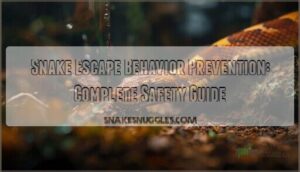This site is supported by our readers. We may earn a commission, at no cost to you, if you purchase through links.

They use their forked tongues to collect chemical information from the air and ground, processing these signals through a special organ called the vomeronasal organ. This chemical "tasting" reveals territory markers, mating availability, and danger warnings from other snakes.
Visual displays like coiling, head positioning, and tail movements also convey messages about aggression or submission. Vibrations through the ground carry information about approaching threats or potential mates.
Even their infamous hissing serves as a clear "back off" signal. The intricate world of serpent communication reveals surprising complexity in how these silent predators navigate social interactions and survival challenges.
Table Of Contents
- Key Takeaways
- Snake Communication Methods
- How Snakes Communicate Behavior
- Defensive Behavior Strategies
- Mating and Combat Tactics
- Sensory Abilities and Signals
- Frequently Asked Questions (FAQs)
- How do snakes communicate?
- What is the communication system of a snake?
- How do snakes express emotions?
- How do snakes use visual communication?
- Do snakes communicate with their offspring after birth?
- Can environmental changes affect snake communication patterns?
- How do juvenile snakes learn to communicate?
- Are there differences in communication between wild and captive snakes?
- Do snakes use communication to coordinate group movements?
- Conclusion
Key Takeaways
- You’ll rely mainly on chemical signals – Snakes use their forked tongues and vomeronasal organ to detect pheromones that reveal other snakes’ species, sex, and reproductive status through chemical analysis.
- You can read their body language – Defensive postures like coiling, hissing, and head positioning communicate clear threat warnings, while ground vibrations alert them to approaching danger or potential mates.
- You’ll see sophisticated mating rituals – Males engage in wrestling matches and perform rhythmic courtship displays, using tactile communication and physical touches to establish dominance and attract females.
- You won’t hear much vocalization – Unlike many animals, snakes communicate primarily through silent methods, with hissing serving mainly as a defensive "back off" signal rather than complex social communication.
Snake Communication Methods
You might think snakes are silent, but they actually use a sophisticated mix of pheromone trails, tongue flicking, and specialized organs to send messages.
By analyzing chemical cues and subtle movements, you can decode how these reptiles communicate everything from courtship to territory—no need for a secret decoder ring to understand their sophisticated communication methods.
Pheromone Trails
When you’re tracking a snake’s movements, you’re actually following chemical breadcrumbs called pheromone trails.
Think invisible highways of scent—snakes leave chemical breadcrumbs that guide others straight to their location.
Female snakes deposit these lipid-based chemical signals through their skin as they move, creating invisible highways that males can detect and follow.
These snake pheromones contain complex molecular information about the female’s species, reproductive status, and recent activity.
Males use specialized trail following behavior, tongue-flicking to collect these chemical trails from surfaces.
This scent marking system works like a GPS for love, guiding males directly to receptive females during breeding season.
Researchers have also discovered that snakes can detect airborne pheromone signals which play a vital role in their mating behavior.
Vomeronasal Organ
While pheromone trails provide the roadmap, your snake’s vomeronasal organ serves as the sophisticated GPS system that reads these chemical messages.
This remarkable sensory apparatus, also called Jacobson’s organ, sits in the roof of the mouth and processes chemical information with incredible precision.
- Dual-chamber design: Each vomeronasal system contains two separate chambers that analyze chemical samples from both tongue forks
- Direct brain connection: Jacobson’s organs send signals straight to the brain’s limbic system, bypassing regular smell pathways
- Species-specific receptors: Snake sensory organs contain specialized cells that detect only relevant pheromone signals from their own species
- Enhanced sensitivity: The vomeronasal organ detects chemical concentrations thousands of times lower than regular olfactory reception
- Continuous sampling: Your snake’s system processes new chemical data every few seconds through constant tongue flicking and insertion
The study of vomeronasal products has greatly advanced our understanding of snake communication methods.
Chemical Signal Detection
After the vomeronasal organ picks up environmental traces, your snake’s world revolves around Pheromone Detection.
Chemical cues—think lipid signals and specialized pheromones—act as nature’s invisible text messages.
The vomeronasal system processes these signals with impressive sensitivity, letting snakes distinguish age, sex, and even recent activity.
Snake chemical communication relies on signal transmission through these chemical signals, guiding behavior and social interactions.
Snakes utilize their chemoreception systems to detect and interpret these chemical cues, guiding their actions through nature’s invisible text messages and using specialized pheromones for communication.
Tongue Flicking Mechanism
Precision drives every tongue movement as your snake samples the environment.
Every flick decodes nature’s chemical alphabet with surgical precision.
Each flick collects airborne particles and chemical signals, delivering them to the vomeronasal organ for analysis.
The bifurcated tongue provides directional smelling capabilities, with each fork offering separate chemical samples.
This vomeronasal stimulation creates a detailed chemical map, enabling snake communication through pheromone detection and environmental assessment.
How Snakes Communicate Behavior
Understanding snake communication behavior reveals a fascinating world where serpents navigate their environment through sophisticated signaling systems.
You’ll discover that snakes rely on multiple communication channels to survive and thrive in their ecosystems.
Snake communication methods operate through three primary channels:
- Chemical signals – Snakes detect pheromones through their vomeronasal organ, gathering critical information about other snakes’ presence, sex, and reproductive status
- Vibrational signals – Ground-borne vibrations travel through their bodies, alerting them to approaching predators, prey, or potential mates
- Snake body language – Visual displays like coiling, head positioning, and body postures convey immediate behavioral intentions
These behavioral cues work together during social interactions, helping snakes interpret their surroundings accurately.
Environmental adaptations have fine-tuned these communication systems over millions of years.
Snake vocalizations, though limited, complement these primary methods.
Each signal type serves specific purposes, from territorial disputes to courtship rituals, creating a complex communication network that guarantees species survival.
The use of chemical communication strategies is vital for snakes to convey information and navigate their social structures.
Defensive Behavior Strategies
When you encounter a snake in the wild, you’ll notice it relies on specialized defensive strategies like tail rattling, hissing, and body posturing to warn off threats.
These behaviors aren’t just dramatic displays—they’re essential survival signals that communicate a clear message: keep your distance or risk a defensive response.
Tail Rattling
Most rattlesnakes produce their signature rattle sounds by vibrating specialized tail segments at lightning speed—up to 100 times per second.
This threat display creates defensive noise that warns potential predators to back off. The rattlesnake rattle evolved from simple tail vibrations used by many snake species.
Even non-venomous snakes mimic these vibrational signals, shaking their tails against leaves or debris to create similar ground vibrations and snake warning sounds for protection.
Corn snakes exhibit a unique form of defense mechanism behavior that helps them deter predators and communicate with other snakes, using a defense mechanism to protect themselves.
Hissing and Musk Release
Beyond tail rattling, you’ll encounter two more potent defensive mechanisms when snakes feel cornered.
Hissing sounds serve as audible warning signals, created when air’s forced through the glottis. Meanwhile, musk secretion releases foul-smelling chemical signals that confuse predators like nature’s stink bomb.
Here are three key aspects of these threat displays:
- Hissing intensity varies – Louder hisses indicate higher stress levels and imminent defensive action
- Musking timing matters – This alarm cue typically follows failed visual defensive postures
- Combined effectiveness – Both mechanisms work together, creating multi-sensory deterrent strategies
Coiling and Posturing
When you spot a snake coiling into an S-shape with its head raised, you’re witnessing classic defensive posturing.
This body language serves as a clear threat display, warning potential predators to back off.
The coiled position allows quick striking capability while the elevated head provides better visual assessment.
These defensive postures represent sophisticated warning behaviors that help snakes avoid unnecessary confrontations through intimidating posture signals.
Striking and Biting
When defensive postures fail to deter threats, you’ll witness snakes’ final warning signals through striking and biting behaviors.
These aggressive postures involve lightning-fast strike speed and precise fang structure positioning for maximum venom delivery effectiveness.
Attack patterns vary by species, with bite force calculated to immobilize threats instantly, and defensive behaviors escalate systematically, making snake interaction predictable when you recognize their warning signals.
Mating and Combat Tactics
When you’re watching snakes during breeding season, you’ll witness intense competitions where males engage in wrestling matches to win mating rights with females.
These serpents communicate through a complex combination of chemical signals, physical touches, and ground vibrations that determine who gets to pass on their genes, involving intense interactions.
Male Competition
Male snakes’ territorial displays reveal nature’s most dramatic power struggles.
When breeding season arrives, ritualized combat becomes their primary language of dominance hierarchy establishment.
Combat behavior involves these key agonistic behaviors:
- Wrestling matches – Males lift their bodies vertically, attempting to topple rivals through sheer physical strength
- Body pinning – Winners maintain dominant positions by crawling over and physically restraining subordinates
- Submission signals – Defeated males display head lowering and coiling postures, clearly communicating defeat.
This malemale combat determines reproductive access, with larger males consistently winning these snake dominance displays.
Courtship Displays
Once the dust settles from male competition, courtship displays take center stage. You’ll notice snake dancing—males perform rhythmic movements and gentle touches as courtship signals.
These mating rituals showcase strength and finesse, aiming for female attraction. Females respond with subtle cues, setting the stage for mating behavior.
Understanding snake mating behaviors involves studying snake mating toys.
| Courtship Signal | Purpose |
|---|---|
| Rhythmic Movements | Display male fitness |
| Gentle Touches | Assess female response |
Tactile Communication
Beyond visual courtship displays, snakes rely heavily on tactile communication during intimate encounters. Physical contact becomes their primary language when chemical signals aren’t enough.
Here’s how snakes use touch to communicate:
- Gentle rubbing along the female’s body – Males use rhythmic movements to signal romantic interest
- Chin pressing against scales – Creates vibrations that convey readiness and consent
- Intertwining bodies during combat – Males wrestle to establish dominance through physical positioning
- Tail positioning and lifting – Females signal receptiveness through specific body adjustments
- Muscle contractions during mating – Specialized movements maintain proper alignment and stimulation
These tactile interactions involve sophisticated body language where every touch carries meaning. Scale vibrations transmit information about size, strength, and intentions. Touch signals help coordinate complex behaviors, ensuring successful reproduction while minimizing aggressive encounters.
Vibrational Signals
In the domain of snake combat and courtship, vibration detection is your secret weapon.
Snakes sense ground tremors and vibrational cues through their jawbones and belly scales—think of it as seismic communication.
Tail vibrations and groundborne vibrations aren’t just noise; they’re essential signal transmission tools.
While vibrational ecology shapes defensive moves, these vibration signals rarely serve as complex social cues between snakes.
Sensory Abilities and Signals
You’ll discover that snakes rely on four main sensory channels to communicate behavioral messages with remarkable precision.
These serpents combine ground vibrations, airborne sounds, visual cues, and chemical analysis to create a sophisticated communication network that rivals any modern messaging system.
Ground-Borne Vibrations
After all that wrestling and courtship, snakes tune into a different channel—ground-borne vibrations.
Using their lower jaws, they sense even faint seismic signals and ground tremors.
This unique vibration detection lets them pinpoint prey, spot rivals, and read territorial vibrations.
Think of it as their own vibrational ecology, where tactile communication and vibrational cues keep them safe and informed on the move.
The study of seismic signals relies on advanced vibration sensor technology to detect and analyze these subtle movements and understand the importance of seismic signals.
Airborne Sound Detection
While ground vibrations tell part of the story, you’ll find that snakes also process airborne sounds through a limited but fascinating auditory system.
Their hearing range typically spans 80 to 600 Hz, with some species detecting frequencies up to 1,000 Hz.
Here’s what makes their sound detection unique:
- Frequency Detection occurs through bone conduction rather than external ears
- Sound Waves travel through their skulls to reach inner ear structures
- Airborne Vibrations are less effective than ground-borne signals for communication
- Sonic Signals like hissing may not be heard by other snakes in most species
- Vocalizations serve primarily as predator deterrents rather than intraspecies communication
This acoustic communication system remains somewhat mysterious to researchers studying snake behavior.
Visual Displays
You’ll notice visual displays complement auditory signals in snake communication.
Body language speaks volumes through posture displays and tail positions. Color signals flash warnings or attraction cues during breeding season.
Eye contact establishes dominance hierarchies among competing males. Defensive postures like coiling and neck flattening communicate "back off" messages to potential threats.
Tail vibrations create visual motion patterns that reinforce territorial boundaries. Snakes utilize their visual perception abilities to detect and respond to these visual cues.
Chemical Cue Analysis
While visual displays catch your eye, snakes rely on Pheromone Detection and Chemical Signals for real communication.
Their Vomeronasal System reads pheromones from scent marking, picking up subtle cues left in trails or on skin.
Through Lipid Analysis, snakes interpret snake pheromone signals, using chemoreception to decode age, sex, and readiness.
Chemical cues guide everything from courtship to territory defense—no words needed.
Frequently Asked Questions (FAQs)
How do snakes communicate?
Snakes primarily communicate through chemical signals called pheromones, which you’ll detect through their specialized Jacobson’s organ. They also use vibrations, defensive postures, and tactile movements during mating interactions.
What is the communication system of a snake?
You’ll find that serpents rely on sophisticated chemical messaging through their forked tongues and Jacobson’s organ.
They detect pheromones revealing age, sex, and reproductive status.
They use vibrations, hissing, and defensive postures to communicate territorial boundaries and threats effectively.
How do snakes express emotions?
Ever wonder how these silent serpents show their feelings?
You’ll observe snakes expressing emotions through defensive postures, chemical signals, and body language rather than vocalizations.
Using hissing, coiling, and pheromone release to communicate their emotional states.
How do snakes use visual communication?
Unlike mammals, you’ll notice snakes rely minimally on visual cues for communication.
They primarily use body postures, coloration changes, and movement patterns rather than complex visual displays to convey territorial or mating information, which is a key aspect of their communication.
Do snakes communicate with their offspring after birth?
You won’t catch a mother snake whispering sweet nothings to her babies.
After birth, there’s no parental guidance—offspring rely on instinct alone.
It’s a tough world, but those little hatchlings are hardwired to survive solo.
Can environmental changes affect snake communication patterns?
Nearly 80% of snakes rely on pheromones for communication, so if pollution or habitat loss messes with chemical trails, you’ll see disrupted mating and territorial cues.
Imagine trying to text your friend, but the signal’s gone!
How do juvenile snakes learn to communicate?
Juvenile snakes learn communication through genetic programming and environmental observation.
They’re born with innate abilities to detect pheromones and produce defensive behaviors, then refine these skills by watching adults and practicing responses to stimuli.
Are there differences in communication between wild and captive snakes?
Wild snakes face environmental pressures that captive ones don’t, creating communication differences.
You’ll notice wild snakes use more complex pheromone trails and territorial displays, while captive snakes show reduced chemical signaling due to limited space and controlled conditions, which affects their communication.
Do snakes use communication to coordinate group movements?
Most snakes don’t coordinate group movements since they’re primarily solitary creatures.
You’ll rarely see them working together like pack animals.
However, during hibernation or mating season, they’ll gather but communicate through individual chemical signals rather than coordinated group behavior.
Conclusion
**Silent signals secretly showcase snakes’ sophisticated survival strategies.
**Understanding how snakes communicate behavior reveals nature’s remarkable adaptation to life without vocal cords.
You’ve learned that chemical detection through tongue-flicking and the vomeronasal organ forms their primary communication network.
Visual displays, vibrations, and defensive postures create a complex behavioral language that’s both practical and precise.
This knowledge helps you appreciate these misunderstood creatures’ intricate social interactions and survival mechanisms in their natural environments.
- https://medium.com/@mariyamshahid694/snakes-can-speak-unraveling-the-mysteries-of-serpent-communication-3c7e7b04a80f
- http://www.saintpetersburgsnakes.com/snakecommunicatehow.html
- https://envirobug.com.au/blogs/envirobug-blog/understanding-snake-body-language-how-to-read-their-signals?srsltid=AfmBOooMgIDv65FzL-brOZEnn3p04J8-5SJGbtGAO3VCQAmysrFZ3Xxq
- https://www.sittingforacause.com/blog/pet-fun/5-snake-behaviors-explained/
- https://californiaherps.com/behavior/snakelifehistorydefense.html
















